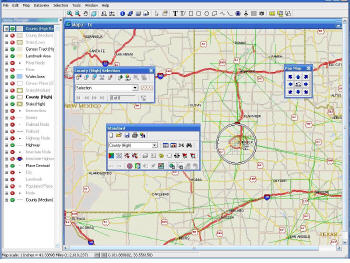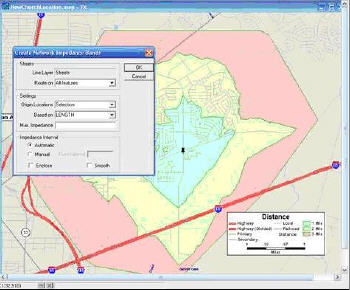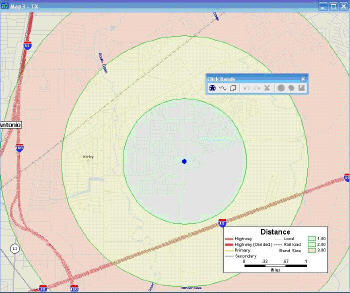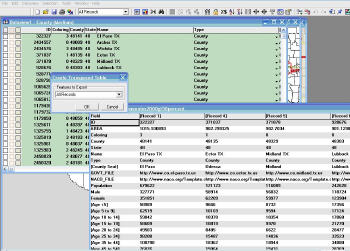Basics of Maptitude
I have used GIS of some sort or another since the early 1980s. Each program I used had a learning curve that varied dependent upon how different it was from a standard computer program. I have found that Caliper's learning curve is relatively shallow.
Maptitude uses its own proprietary compressed geographic files but can import vector, raster and point-based geographic data from a variety of GIS vendors (including ESRI Shape files and MapInfo TAB files). The geographic files become layers within a "map" window. Data for these layers can be reviewed or edited within a "dataview" window. Users can also create figures and charts and view them within a "figure" window. Elements of all of these windows can be placed within a "layout" window. While information from each of the windows (maps, figures or dataviews) can be saved or printed directly, the layout allows the user to create an output of all of the elements together.
Maptitude 5.0 Look and Feel
In version 5.0, Caliper changed Maptitude's look and feel - but did it in such a way that current users will find many of the features and tool bars familiar. In fact, I found it very easy to use despite the fact that I had been using a version several iterations removed from this one. This version allows you to dock your toolbars on the side or at the top, or to let some or all float on the screen. While I like this change and find it helpful to customize my work window, I found that at times I lost track of a particular function button and that the display was sometimes overly cluttered. This may have been less of a problem if I had been using a larger (or dual) computer monitor.
 |
In previous versions, users panned through their maps using a hand tool and dragging the map in one direction or the other. This function remains in version 5.0, but users can now pan through the map by pointing on a directional button within a new "pan map" toolbar. Another function I really like that I don't recall seeing in other GIS programs is a magnifier tool. Essentially, if you want to see a particular area on your map at a larger scale without zooming in, you can hover the magnifier over that area. This may be especially useful when working with aerial or satellite images.
With previous versions of Maptitude, I became frustrated with some of the limitations I had in changing the formatting of geographic feature labels and feature displays. Default values for certain Caliper-created geographic files were virtually impossible to change. In version 5.0, Caliper added a display manager toolbox which provides more detailed information about the geographic features within a map window and how elements of those features are displayed and labeled. This provides the user greater flexibility in changing some or all of the elements shown within a window. When available, the Federal Geographic Data Committee standard metadata can be displayed through this display manager toolbox. Unfortunately the metadata are not attached to current Caliper-created geographic files.
Users often work with more than one map at time. You can now keep all those maps at the same scale through the new synchronize map tool. When selecting this tool, you link together one or more open maps. As you zoom in or out within your working map, the other linked maps will follow.
If Caliper added no other features than the following two, I think many current users would still find it worthwhile to upgrade.
- In previous versions, maps pointed to one or more geographic files located in a directory on the user's computer (or on a CD-ROM). When one or more of those files were moved to other directories, the user had difficulty reopening the maps in Maptitude unless he recalled where those files were moved. In version 5.0, a geographic file locator has been added so that the program automatically searches for the missing file.
- The undo/redo tool is Caliper's response to an often requested feature from Maptitude's user community. Although the feature is not available when working within all aspects of Maptitude, it is handy to use when editing geographic features or data elements - a critical part of data development.
Caliper has always included a wide range of analytical functions within Maptitude. A great deal of GIS work involves selecting areas based upon a range of criteria. This is done in Maptitude through a selection toolbox. Prior to version 5.0, users could also perform terrain analysis, create a vector layer based upon areas of influence (Thiessen Polygons or Voronoi diagrams), create overlays or bands (buffers), or merge areas based upon selected criteria. In addition to these features, Caliper has added several functions for point pattern and network related analyses.
Density grids can be created from point data in order to see where hot spots are located (such as crimes within a city). These density grids can be weighted based on a single factor. In addition to density grids, users can use Maptitude to determine service areas and locate facilities based on point data. Service areas can be created that encompass all the points within a layer or that are weighted by some value within the point data. In version 5.0, field values from areas can be added to all points located within the selected area using the new "tag by area" tool.
Maptitude includes several functions for terrain analysis. In addition, imagery files can be imported as layers within the GIS.
Caliper's flagship program, TransCAD, includes many transportation (i.e. network) specific analytical functions, so it is not surprising that many basic network analysis functions are included in Maptitude. In addition to the routing functions available in previous versions, version 5.0 includes new network analysis capabilities. Now users can create bands along a network based on distance, time or other impedance factors. In previous versions of Maptitude, users could create districts or zones based on vector layer attributes. This capability is extended in Maptitude 5.0 by adding the ability to create zones or districts based on proximity of points along a network.
 |
Many users will find the "click band" tool useful. In previous versions, you had to create a point layer in order to create an overlay to analyze data around an area within a certain mileage of a particular location. In Maptitude, the steps to performing this analysis are shortened by allowing you to click a point on the map and have Maptitude create a vector layer based upon that point (without creating an extra point layer).
 |
Users can now create desire lines which show the connections between origins and destinations on a map. In my case, I mapped the volume of commuter flows between origin and destination counties. The desire lines reference a geographic layer on the map and a table of values. The table of values must include fields for origins and destinations which match ID fields in the geographic layer. Unfortunately, these appear to be limited to the internal IDs given by Caliper, so I had to export a table of field values from my selected geographic file and merge this exported field twice by matching FIPS codes with my own data. Once this was completed, I was able to create the desire lines with relative ease. However, it would have been easier had I been able to match my FIPS codes with the geographic layer FIPS codes directly. Still, this analytical function will be very useful in my work.
At times it is useful to transpose tables so that rows become columns and vice versa. This ability has been added to Maptitude by allowing users to transpose tables within a dataview. This can include all the data represented within a geographic feature or just a selected subset of those data. The function creates a new dataview with the transposed data displayed. These data can then be saved and exported to other software programs.
Finally, users are not limited to the tools and functions packaged with the software. Caliper allows users to customize and add other functions using Caliper's GISDK programming language.
 |
Included Data
The Maptitude program and data are on one DVD. There are 51 data files included on the DVD and users can purchase others through Caliper's website. The data include basic streets (2007), ZIP Codes (2007), water and landmark features, as well as 2000 demographic data and 2006 population estimates from the U.S. Census. Demographic data are available for states, counties, ZIP Codes and Census Tracts. Caliper includes the U.S. Census Bureau's 2006 county population estimates by sex, race, ethnicity and age. Caliper's population estimates for Census Tracts were derived from these county estimates. Unfortunately, there is little detail within the Maptitude documentation or on Caliper's website to understand the methods used to create these estimates. As a user and sometimes creator of data, I would have preferred more metadata about the included data items.
I remain impressed with the analytical tools available within Maptitude. It is a product that offers more value than similarly priced GIS and desktop mapping software programs. While previous versions have included many of the tools that I most use, there were some limits to what could be done. Caliper has added more analytical capabilities and additional functions in this version that make it an even more powerful GIS program. Version 5.0's new look and feel, new toolbars and toolbar functions, and other enhancements will be well received by current users. I consider the few issues I had with version 5.0 to be minor, and in some cases, only a matter of personal preference.
Maptitude 5.0 is available for personal computers running Microsoft 2000, XP or Vista with 32 MB RAM and 170 MB of free hard disk space. New users can purchase the product for $495, while current users can upgrade their versions for as little as $250, depending on current licensing. Additional demographic and transportation related data can be purchased directly from Caliper.
Michael Cline is a research scientist at the Institute for Demographic and Socioeconomic Research at the University of Texas at San Antonio. All opinions are his own and do not reflect the view of the University of Texas at San Antonio.